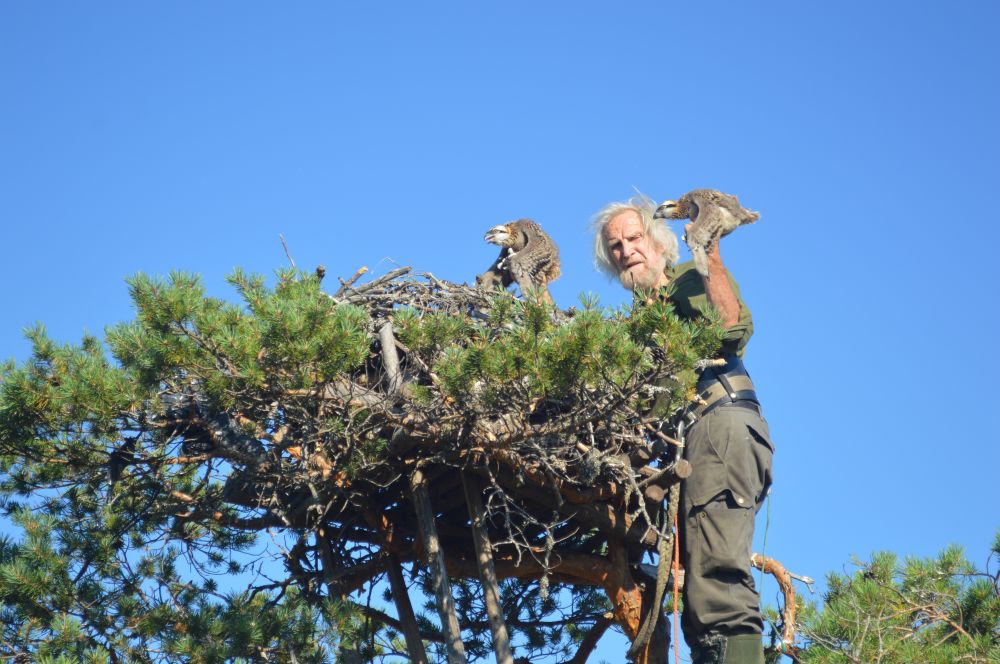A large bird, similar to seagull in its colouring, hovers above the shallow water near the shore. After a while, it pulls back its wings and plunges into the water with a loud splash. The osprey rises from the water, but has no prey. New attempt, the osprey’s gaze is glued to the fish swimming close to the surface and, immediately, the osprey plunges back into the water. Only at the last second its feet push forward and its sharp talons prepare for the attack.
Water droplets fly everywhere as the osprey dives underwater for a moment, struggles with a fish, and then, finally, rises back into the air. From the water rises a silver-scaled bream, caught in the osprey’s claws. After catching such a handsome prey, the male bird rises higher and brings the bream straight to the nest where the hungry female and nestlings are waiting.
The osprey is believed to have been a sacred bird to the ancient Finns and it has been chosen as the regional bird of the Kanta-Häme region. The osprey is also a cosmopolitan bird species that is encountered as subspecies in different parts of the world. Finnish ospreys winter mainly in West Africa.
Back in the day, the osprey was believed to be a fish thief and there was a bounty on its head. In 1926, the osprey was protected with a decree and in 1962, with a law. The nest and nesting tree of an osprey are also protected.
Since then, environmental toxins became the reason for the poor nesting of the species. Thankfully, the situation improved and now the Finnish osprey population is full of life and has 1,200–1,300 nesting pairs.
The patient and long-term conservation work has been effective, but it still requires annual monitoring of the nesting population, undisturbed nesting locations and trees suitable for nesting. Nowadays, people hold ospreys in positive regard and they want to actively participate in the conservation of the species.
Ospreys in Finnish folklore
There are dozens of lakes, bays, hills, archipelagos, islands, wilds, and swamps in Finland, and in the Häme, Satakunta and Savo regions especially, whose names begin with either the word sääksi or sääks, both of which refer to the osprey’s Finnish name sääksi.
The locations have been named after ospreys’ nesting or hunting places. The osprey’s fishing skills in particular have caught people’s attention.

Wikipedia (general information about ospreys)
1. Osprey research
In Finland:
Ospreys in Finland 1890–1990 – a historical account and the blind spots in the research
Outside of Finland:
2. Nest cameras in osprey nests
3. Videos and photographs of ospreys
4. Keskustelufoorumit yms.
Since 2001, there have been over 30 ospreys in Finland equipped with satellite transmitters, through which the birds’ movements have been monitored in detail. The transmitters have also provided valuable information about the migration routes, rest stops, and wintering areas.
There are information and maps about these ospreys’ migration routes available on the website of the Finnish Museum of Natural History (www.luomus.fi/fi/satelliittisaakset).
The live broadcasts from the nests of few of the osprey families offer new research information about what kind of a fish diet ospreys eat and how they behave during nesting. The color ring of the adult bird's feet can be read on the visual recordings without disturbing the birds. The information on the ring tells the adult bird’s place of birth and might even tell something about the different stages of its life. This information is very important to the research. Following both the happy and the sad days of the osprey family via the osprey live online service is very interesting.

Photo: The satellite osprey Ilpo has carried a transmitter for six years and has provided valuable information about its movements.
The national osprey project is an impressive example of the work bird ringers do for the benefit of the Finnish nature. In 1971, bird ringers took the osprey under special monitoring and since then almost all reported osprey nests have been checked every year. Professor Pertti Saurola and superintendent Jari Valkama are in charge of the osprey project.
In 2019, about a hundred osprey ringers participated in the checks and almost 1,200 inhabited nests were discovered. The nestling yield per nest has in the last few years been two ringing-aged osprey nestlings, which can be considered a good result.
The project was only a few years old when it was noted that the lack of suitable nesting trees in peaceful environments was a threat to the Finnish osprey population. Nowadays, over a half of all osprey couples nest in artificial nests made by bird enthusiasts.
